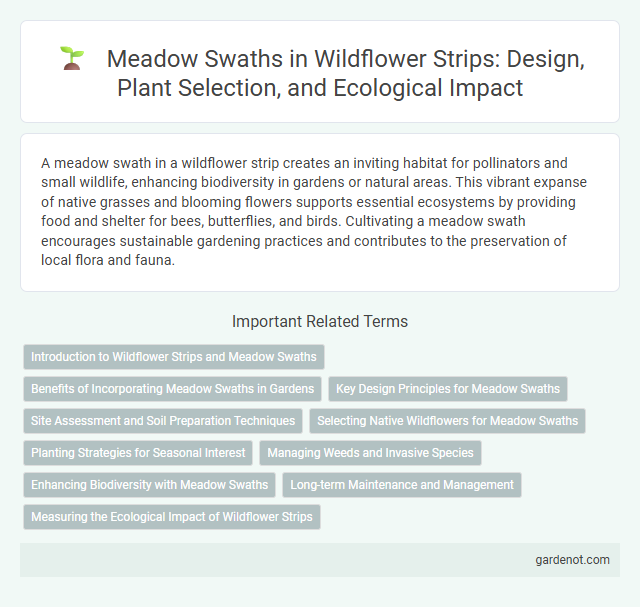A meadow swath in a wildflower strip creates an inviting habitat for pollinators and small wildlife, enhancing biodiversity in gardens or natural areas. This vibrant expanse of native grasses and blooming flowers supports essential ecosystems by providing food and shelter for bees, butterflies, and birds. Cultivating a meadow swath encourages sustainable gardening practices and contributes to the preservation of local flora and fauna.
Introduction to Wildflower Strips and Meadow Swaths
Wildflower strips and meadow swaths create biodiverse habitats by combining native grasses and wildflowers to support pollinators and wildlife. These linear plantings enhance ecosystem services such as soil health, water retention, and carbon sequestration while providing aesthetic and agricultural benefits. Implementing wildflower strips alongside crop fields encourages natural pest control and increases overall farm resilience.
Benefits of Incorporating Meadow Swaths in Gardens
Meadow swaths enhance garden biodiversity by providing essential habitats for pollinators such as bees and butterflies, promoting ecological balance. Incorporating native wildflower species in these swaths improves soil health through natural nitrogen fixation and supports beneficial insects that aid in pest control. These vibrant, low-maintenance areas also contribute to carbon sequestration and reduce soil erosion, making them valuable assets for sustainable garden design.
Key Design Principles for Meadow Swaths
Meadow swaths in wildflower strips are designed with principles that emphasize biodiversity, ecological function, and aesthetic value. Key design principles include selecting native plant species that provide continuous bloom periods to support pollinators, ensuring structural diversity through varying plant heights and densities, and considering site-specific soil and light conditions for optimal growth. Integrating these elements maximizes habitat connectivity, enhances ecosystem services, and promotes sustainable wildlife corridors.
Site Assessment and Soil Preparation Techniques
Effective site assessment for establishing a wildflower strip involves analyzing soil texture, pH levels, and nutrient content to select appropriate native species that thrive in meadow conditions. Soil preparation techniques include deep tilling to improve aeration, removing invasive plants, and incorporating organic matter to enhance fertility and moisture retention. Proper assessment and preparation ensure optimal seed germination, growth, and biodiversity in the meadow swath.
Selecting Native Wildflowers for Meadow Swaths
Selecting native wildflowers for meadow swaths enhances local biodiversity and supports pollinator populations by providing essential nectar and habitat. Species like purple coneflower (Echinacea purpurea), black-eyed Susan (Rudbeckia hirta), and butterfly milkweed (Asclepias tuberosa) thrive in diverse soil conditions and attract bees, butterflies, and other beneficial insects. Prioritizing regional wildflowers ensures ecological compatibility, reduces maintenance needs, and promotes natural regeneration in wildflower strips.
Planting Strategies for Seasonal Interest
Meadow swath planting strategies for seasonal interest prioritize selecting native wildflower species with staggered bloom times to ensure continuous color from spring through fall. Incorporating a mix of perennials, grasses, and annuals enhances structural diversity and supports pollinators across all seasons. Strategic grouping and layering of species optimize light exposure and soil moisture use, promoting sustainable growth and vibrant meadow aesthetics throughout the year.
Managing Weeds and Invasive Species
Managing weeds and invasive species in a wildflower strip requires consistent monitoring and targeted removal to maintain biodiversity and promote native plant growth. Techniques such as selective mowing, hand-weeding, and the use of organic herbicides support controlling aggressive species like Canada thistle and Japanese knotweed. Establishing periodic assessments during the growing season helps detect early invasions, ensuring the meadow swath remains a thriving habitat for pollinators.
Enhancing Biodiversity with Meadow Swaths
Meadow swaths create diverse habitats by supporting an array of native wildflowers and grasses, which attract pollinators like bees, butterflies, and birds. These strips improve soil health and provide essential resources for wildlife, contributing to ecosystem resilience. Strategic planting of meadow swaths enhances biodiversity by connecting fragmented habitats and fostering ecological balance.
Long-term Maintenance and Management
Meadow swath long-term maintenance and management involves periodic mowing once or twice a year to prevent woody plant encroachment and promote wildflower diversity. Prescribed burns or selective grazing can enhance soil health and control invasive species, supporting native pollinators and wildlife habitats. Monitoring plant species composition ensures the meadow swath remains resilient, ecologically balanced, and visually vibrant over time.
Measuring the Ecological Impact of Wildflower Strips
Meadow swaths within wildflower strips serve as critical habitats supporting pollinator diversity and soil health, measured through metrics such as species richness, pollinator visitation rates, and soil microbial activity. Quantitative assessments of these ecological indicators reveal the positive correlation between wildflower strip size and biodiversity enhancement. Data-driven insights from longitudinal studies confirm that strategically placed meadow swaths significantly contribute to ecosystem resilience and agricultural sustainability.
Meadow swath Infographic

 gardenot.com
gardenot.com